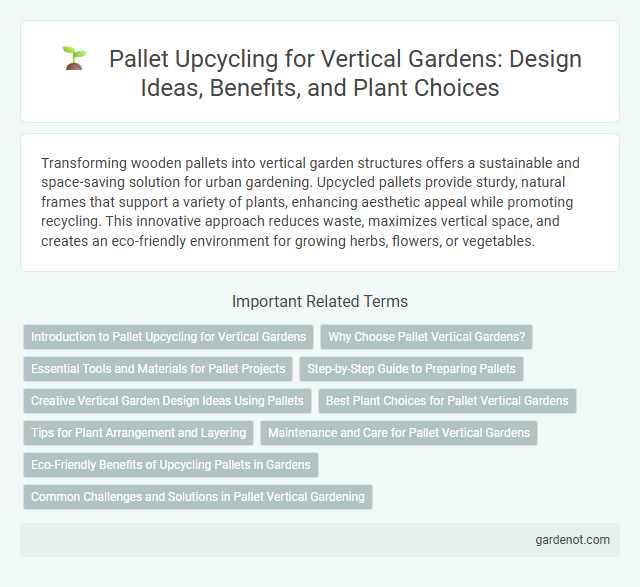Transforming wooden pallets into vertical garden structures offers a sustainable and space-saving solution for urban gardening. Upcycled pallets provide sturdy, natural frames that support a variety of plants, enhancing aesthetic appeal while promoting recycling. This innovative approach reduces waste, maximizes vertical space, and creates an eco-friendly environment for growing herbs, flowers, or vegetables.
Introduction to Pallet Upcycling for Vertical Gardens
Pallet upcycling transforms discarded wooden pallets into functional vertical garden structures, promoting sustainable gardening practices. Repurposed pallets provide an eco-friendly framework for planting herbs, succulents, or ornamental plants in limited spaces. This method reduces waste while creating aesthetically pleasing green walls that enhance urban environments.
Why Choose Pallet Vertical Gardens?
Pallet vertical gardens offer a sustainable and cost-effective solution for urban gardening by repurposing discarded wooden pallets into functional green spaces. These gardens maximize space efficiency, making them ideal for small balconies or limited outdoor areas while promoting environmental conservation through upcycling. Their customizable structure allows for diverse plant arrangements, enhancing both aesthetic appeal and air quality in compact living environments.
Essential Tools and Materials for Pallet Projects
Essential tools for vertical garden pallet projects include a power drill, hammer, saw, measuring tape, and sanding block to ensure precise cutting and assembly. Materials such as untreated wooden pallets, weather-resistant nails or screws, landscape fabric, and waterproof sealant are crucial for durability and plant safety. Using rust-resistant hardware and eco-friendly finishes prolongs the garden's lifespan while maintaining environmental sustainability.
Step-by-Step Guide to Preparing Pallets
Start by selecting sturdy, untreated wooden pallets free from chemical treatments to ensure safety for plants. Disassemble the pallets carefully, removing nails and sanding rough edges to create smooth surfaces optimal for planting. Seal the wood with eco-friendly, non-toxic sealants to protect against moisture while maintaining a healthy environment for vertical garden growth.
Creative Vertical Garden Design Ideas Using Pallets
Creative vertical garden design ideas using pallets transform recycled wood into functional green spaces, maximizing small areas efficiently. Pallet upcycling offers an eco-friendly solution, integrating planters, herb gardens, and succulents in customizable, modular layouts. These designs enhance urban environments by bringing nature indoors or onto patios with minimal cost and sustainable materials.
Best Plant Choices for Pallet Vertical Gardens
Wooden pallets provide an ideal structure for vertical gardens, supporting plants like succulents, ferns, and herbs that thrive in well-drained environments. Strawberries and small flowering plants such as pansies or petunias also adapt well to the shallow soil pockets within pallet slats. Choosing drought-tolerant and compact plants ensures healthy growth while maximizing space efficiency in pallet upcycle vertical garden designs.
Tips for Plant Arrangement and Layering
Maximize space and visual appeal in vertical gardens by arranging plants based on their light and water needs, placing drought-tolerant species like succulents at the top and moisture-loving plants such as ferns near the bottom. Use pallets vertically, securing containers or planting pockets to create distinct layers that improve airflow and drainage. Incorporate trailing plants like ivy in lower layers to add depth and soften the structure's edges, enhancing the overall aesthetic.
Maintenance and Care for Pallet Vertical Gardens
Pallet vertical gardens require regular maintenance such as watering, pruning, and monitoring for pests to ensure healthy plant growth. Applying a protective sealant to the wood extends the pallet's lifespan by preventing moisture damage and rot. Proper drainage and occasional cleaning of the containers help maintain optimal soil conditions and reduce the risk of mold or mildew buildup.
Eco-Friendly Benefits of Upcycling Pallets in Gardens
Upcycling pallets in vertical gardens significantly reduces waste by repurposing discarded wood, minimizing landfill contributions and decreasing the demand for new raw materials. This sustainable practice lowers carbon footprints as it reduces energy consumption associated with manufacturing new garden structures. Utilizing pallets also promotes biodiversity by creating natural habitats for beneficial insects and plants, enhancing overall garden ecosystem health.
Common Challenges and Solutions in Pallet Vertical Gardening
Common challenges in pallet vertical gardening include structural instability, limited soil depth, and poor water drainage. Solutions involve reinforcing the pallet frame, using appropriate soil mixtures to retain moisture while allowing root growth, and installing drip irrigation systems or adding drainage holes to prevent waterlogging. Selecting untreated, durable wood and applying protective sealants also enhance the pallet's longevity in outdoor vertical garden setups.
Pallet upcycle feature Infographic

 gardenot.com
gardenot.com